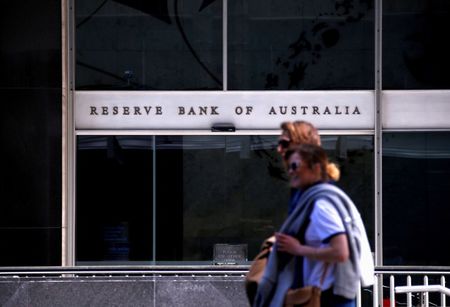
Investing.com– The Reserve Financial institution of Australia is extensively anticipated to maintain rates of interest unchanged in September, though sticky inflation and a robust labor market are more likely to elicit a hawkish outlook from the central financial institution.
The RBA is anticipated to depart its unchanged at 4.35%, a Reuters ballot confirmed.
However the central financial institution is more likely to sign that rates of interest will stay excessive for longer, or may even probably rise additional after inflation remained excessive within the second quarter.
Whereas inflation has steadily declined in latest months, it has achieved so at a barely slower tempo than forecast by the RBA. Core inflation has additionally remained nicely above the RBA’s 2% to three% annual goal vary.
Members of the RBA’s rate-setting board had thought-about charge hikes for not less than the final two conferences, with policymakers fretting over extra potential upside dangers for inflation.
Governor Michele Bullock has additionally repeatedly warned this 12 months that sticky inflation may invite extra charge hikes from the central financial institution.
Whereas costs of products have eased, service worth inflation has remained sticky, particularly amid a robust labor market. Service worth inflation has additionally been a predominant level of competition for the RBA.
Australia’s has broadly defied a downturn in financial exercise, with month-to-month jobs development blowing previous expectations for the previous 5 months.
Whereas the RBA remains to be anticipated to not have sufficient impetus to hike charges, it’s more likely to preserve charges increased for longer and delay any potential plans to start reducing charges.
“We continue to expect the RBA to start its easing cycle in February 2025. But the risks look to have tilted to a later rather than an earlier start, particularly given the current momentum in the labour market,” ANZ analysts wrote in a latest observe.
ANZ expects RBA members to contemplate a hike throughout its September assembly, however to finally choose a maintain.
The RBA’s hawkish outlook contrasts with different main international central banks, who’ve largely begun trimming rates of interest amid cooling inflation and a softer financial outlook.
Most notably, the Federal Reserve had final week minimize charges by 50 foundation factors and flagged the start of an easing cycle that’s anticipated to deliver charges considerably decrease.
How will the ASX 200 react?
Australian shares had benefited significantly from dovish alerts from the Fed, because the prospect of decrease rates of interest noticed buyers pivot into economically delicate sectors. This put the at file highs final week.
However native shares remained weak to profit-taking, with overly hawkish alerts from the RBA more likely to spark a near-term pullback in markets.
Australia’s financial system has additionally cooled quickly over the previous 12 months amid strain from excessive charges, with the prospect of high-for-longer charges presenting a weaker surroundings for native shares.
How will AUDUSD react?
The Australian greenback benefited from a hawkish RBA and a dovish Fed, with the pair lately hitting a close to nine-month excessive.
Any extra hawkish alerts from the RBA are more likely to additional enhance the foreign money.




